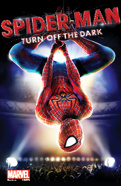Spider-Man Co-Author Glen Berger on Weaving the Web of Turn Off the Dark
About the Author:
Playwright Glen Berger has been a strong presence in New York’s downtown theater scene thanks to plays like Underneath the Lintel, The Wooden Breeks and Max and Ruby, but now Berger is headed up to Broadway…and in a very big way. As co-book writer of Spider-Man, Turn Off the Dark (alongside director Julie Taymor), Berger is bringing the iconic Marvel comic book hero to life onstage in the highly anticipated mega-musical. Broadway.com asked Berger to reflect on his six-year journey with the show, and he took the time to provide fascinating insights into his creative process and the imaginative world of Julie Taymor. Take a read below!
![]()
A show about a young fellow with powers usually reserved for a certain animal. A show with singing, dancing, masks, puppets. A show with demons, demigods and spectacle, all in service of a story with a theme revolving around an individual’s responsibility to the community. This is a description of Spider-Man Turn Off the Dark, sure, but it’s also a description of a performance presented 50,000 years ago. I’m convinced of it. And whatever and wherever that performance was, it wasn’t simply “entertainment”—it was no doubt deeply embedded in ritual and religion.
So from the very start, I was eager and relieved to be working on such a project. The prospect of tapping into something deep, something ancient? There’s no better prod to get me writing. Actually, a fast-approaching deadline is a much better prod, but second to that is the prospect of tapping into something deep and ancient. After all, writing, generally, is a misery. And there’s no telling how long a project will last. So the hope is always that one’s collaborators, and the project itself, tirelessly pushes the limits of what can be artistically plumbed.
Needless to say—since I’ve been on this Spider-Man train for almost six years—it was my great good fortune to land in this particular project with its particular artistic team, a group of seasoned and blazing-eyed folk helmed by the inimitable, indomitable and fairly iridescent Julie Taymor, my co-book writer, as well as director. A project with Julie Taymor involved is, inevitably, a “Julie Taymor Project,” which isn’t to say, however, that it belongs to her. It’s more a question of a crew assembled to rally round a shared vision.
Think of it this way: It's as if Julie woke up from a dream one day to say there’s an uncharted island in the Indian Ocean—it’s a remarkable island and really worth visiting and no one’s ever been there before and she needs shipbuilders and an able-bodied crew to help her reach it. The island finally reached belongs to nobody. But neither would anyone have found it, much less known to look for it, if Ms. Taymor hadn’t dreamed about it first.
So back in 2005, she and I met for a number of day-and-night-long brainstorming sessions—in essence trying to nail down some basic coordinates of this dreamed-about place. From the beginning, we knew we wanted to anchor not just the story but the tone of the show with the timeless pop sensibility and approachability of the Spider-Man comic books created by Stan Lee and Steve Ditko, as well as the also-timeless themes and lyric storytelling of the ancient myths from which Lee and Ditko consciously drew much of their inspiration.
When Spider-Man first hit the scene in 1962, it was an instant hit, and its success has only increased over the last almost-fifty years. Much of that popularity can be traced to Peter Parker. As a character, Peter broke the “superhero” mold—he wasn’t from another planet, or a playboy millionaire, or a model of effortless rectitude. He was a kid with girl troubles, money troubles, employment troubles—he had troubles. And he had a sense of humor. These qualities make him—and the stories revolving around him—instantly vivid and approachable, not just in comic books, television and the movies, but now on stage as well. Peter’s travails and his take on life couldn’t help but dictate the tone of the story and show Julie and I put together over the course of a year.
Meanwhile, before the script had begun to be written, Bono and The Edge—the composer/lyricists—also began participating in some heady marathon sessions where the work at hand was distilling each scene to its essence so that a song for that scene could be constructed. It was grin-inducing and gratifying watching these three co-collaborators with their geeky exuberance for art—their earnest faith in art’s power to inspire and transform. The possibilities inherent in a piece of music with some lyrics attached to it—well, it’s their amphetamine, their dopamine, their lysergic acid, and the buzz was infectious.
So then, after these sessions, I went home and in no time at all the script was written and we put it up on stage. Easy peasy. Or maybe it was a slog. Actually, it was both. Either way, the result is a ride I think audiences will be thrilled that they took.
